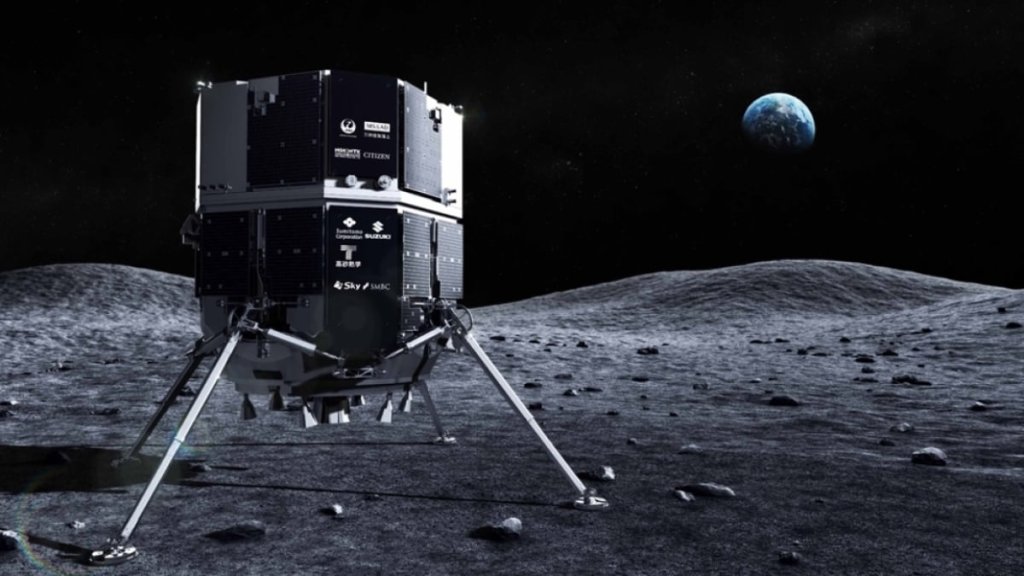
A daring company is about to try landing on the moon. You can watch it. (Image Credit: Mashable)
Other space ventures and spacefaring nations have tried and failed before.
Undeterred by previous flops, a Japanese company will attempt to land a robotic spacecraft on the moon. If it succeeds, ispace could claim the first commercial lunar landing in history.
The company will broadcast the event live at 11:40 a.m. ET April 25, 2023, giving viewers a peek behind the curtains at mission control in Tokyo as engineers oversee the challenging feat. Lunar landings are rare in and of themselves, let alone opportunities for the public to watch them unfold in real time.
The mission, known as HAKUTO-R(opens in a new tab), is one of several commercial lunar missions happening soon. Others in the pipeline are an outgrowth of NASA‘s Commercial Lunar Payload Services Program, established in 2018 to recruit the private sector(opens in a new tab) to help deliver cargo to the moon. Ispace(opens in a new tab), a startup specializing in landing vehicles, couldn’t directly participate in the NASA program because it isn’t an American company, but it is collaborating on a contract led by Draper Technologies based in Massachusetts to land on the moon in 2025.
All these upcoming missions are expected to support the U.S. space agency’s lunar ambitions, shipping supplies and experiments to the surface ahead of astronauts’ arrival in 2025 or later, as well as kickstarting a future lunar economy. For this first attempt by ispace, NASA has a contract to buy lunar dust samples(opens in a new tab) collected during the mission. HAKUTO-R is carrying cargo for several other customers as well: It will try to deliver two rovers, one each from the Emirati(opens in a new tab) and Japanese(opens in a new tab) space programs, to the surface.
“I see this as the beginning of a new phase of commercial missions to the (moon) with 3 #CLPS launches expected from (the United States) in 2023,” said Thomas Zurbuchen, NASA’s former head of science, in a tweet(opens in a new tab).
If the landing is successful, it will also herald the first Arab moon mission, with the Rashid rover(opens in a new tab)‘s planned exploration of the Atlas crater. Sultan Al Neyadi, the first Arab astronaut assigned to a long spaceflight, wished the team good luck(opens in a new tab) from the International Space Station this week.
“I see this as the beginning of a new phase of commercial missions to the (moon) with 3 #CLPS launches expected from (the United States) in 2023.”

Credit: ispace
Ispace’s attempt to land on the moon will be livestreamed on Youtube(opens in a new tab). If conditions change, the team has pinpointed three alternative lunar landing sites. Depending on the location, the landing date could change, officials said. Fallbacks are slated for April 26, May 1, and May 3.
During the landing sequence, the spacecraft will perform a braking engine burn to slow down from orbit. With a series of pre-set commands, the lander will adjust its orientation and speed in order to touch down softly on the lunar surface. The process is expected to take about one hour.
People around the world tuning into the livestream will have a view inside the company’s Tokyo mission control center. The broadcast will also include live and pre-recorded interviews. If the landing succeeds, ispace will provide visual confirmation of the spacecraft on the moon, company spokesman Andrew Ames told Mashable.
HAKUTO-R originated from the Google Lunar XPrize(opens in a new tab) competition, which offered $20 million to the first private spacecraft developer to land, travel 500 meters, and beam back video from the moon. The deal expired before any of the competitors involved made it.
After launching in December 2022 on a SpaceX Falcon 9 rocket from Kennedy Space Center in Cape Canaveral, Florida, the spacecraft has been on a lengthy, five-month journey to the moon to save on fuel costs. It completed a successful orbital injection maneuver, which propelled HAKUTO-R into lunar orbit, on March 21 and its final maneuver prior to landing on April 13.
Want more science and tech news delivered straight to your inbox? Sign up for Mashable’s Top Stories newsletter today.
This is not the first time the private sector has attempted the feat: In 2019, an Israeli nonprofit and company collaborated on the $100 million Beresheet mission, which sought to land on the moon. As the spacecraft descended, an orientation component failed, causing the main engine to cut out.
Mission controllers attempted to reset the spacecraft, but by the time the engine came back on, it was too late: Engineers had lost communication with the vehicle. It crashed into the moon and may have scattered some intriguing artifacts, such as microscopic tardigrades, aka “water bears,” suspended in epoxy. Nova Spivack, co-founder of the Arch Mission Foundation that made the payload, told a Mashable reporter four years ago he hadn’t informed the Beresheet team he was adding the creatures to their cargo.
Brad Jolliff, director of the McDonnell Center for the Space Sciences at Washington University in St. Louis, believes the next five years will see a flurry of other commercial companies following suit, lugging cargo to the moon, and facilitating science experiments.
“There’s a business case for the moon,” Jolliff told Mashable in a previous interview. This new era of lunar exploration and travel “won’t be done entirely by NASA, it will be done with international partners and with commercial partners.”
A version of this story originally published on April 22, 2023.





